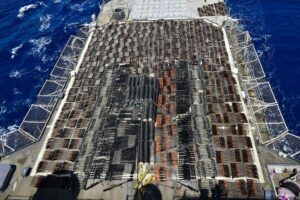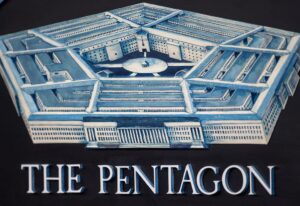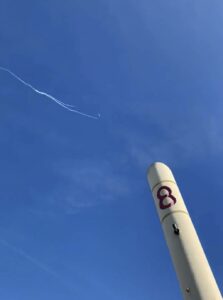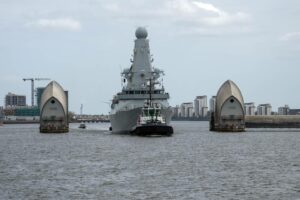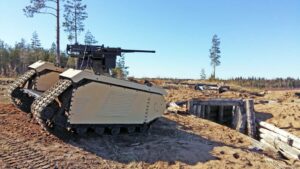WASHINGTON — Diamonds may be forever and a girl’s best friend. They may be the centerpieces of crowns and countless heist films. They may even motivate treasure hunters to plumb the icy grave of the RMS Titanic.
But can they revolutionize battlefield sensors? Raytheon thinks so.
The company, a division of RTX, said it won $15 million from the Defense Advanced Research Projects Agency, or DARPA, to improve gallium nitride semiconductors utilizing the gemstones. Used in radars, gallium nitride components boost power and sensitivity. Temperature management, though, can prove tricky.
To combat overheating, Raytheon is looking to pair lab-grown diamond — a substance known for its incredibly high thermal conductivity — with military transistors and circuits. The company is collaborating with the Naval Research Laboratory, Stanford University and Diamond Foundry to grow the crystal with a particular pattern, or lattice.
“Our engineers have unlocked a new way to produce gallium nitride, where thermal management is no longer a limiting factor,” Colin Whelan, Raytheon’s president of advanced technology, said in a Nov. 16 statement. “These new system architectures will result in sensors with enhanced range.”
RELATED

The four-year prototyping contract was inked as part of DARPA’s Technologies for Heat Removal in Electronics at the Device Scale program. THREADS, as it’s known, aims to overcome the thermal limitations of electronics and circuitry while also enhancing the efficacy of radio-frequency equipment.
“If we can relax the heat problem, we can crank up the amplifier and increase the range of radar,” Thomas Kazior, a DARPA program manager, said in a statement announcing THREADS late last year. “If the program is successful, we’re looking at increasing the range of radar by a factor of 2x to 3x.”
RTX has long invested in and used gallium nitride. It’s found in the company’s SPY-6 family of radars, deployed by the U.S. Navy for overhead defense; the Lower Tier Air and Missile Defense Sensor, expected to replace the Army’s original Patriot air-and-missile defense radar; and more.
RTX is the second-largest defense contractor in the world when ranked by defense-related revenue, earning $39.6 billion in 2022, according to the Defense News Top 100 list.
Colin Demarest is a reporter at C4ISRNET, where he covers military networks, cyber and IT. Colin previously covered the Department of Energy and its National Nuclear Security Administration — namely Cold War cleanup and nuclear weapons development — for a daily newspaper in South Carolina. Colin is also an award-winning photographer.
- SEO Powered Content & PR Distribution. Get Amplified Today.
- PlatoData.Network Vertical Generative Ai. Empower Yourself. Access Here.
- PlatoAiStream. Web3 Intelligence. Knowledge Amplified. Access Here.
- PlatoESG. Carbon, CleanTech, Energy, Environment, Solar, Waste Management. Access Here.
- PlatoHealth. Biotech and Clinical Trials Intelligence. Access Here.
- Source: https://www.defensenews.com/electronic-warfare/radar/2023/11/27/ice-ice-baby-raytheon-uses-diamonds-to-keep-radars-cool/
- :has
- :is
- :where
- $UP
- 1
- 100
- 11
- 16
- 2022
- 70
- a
- According
- administration
- advanced
- Advanced Technology
- agency
- aims
- AIR
- also
- an
- and
- Announcing
- AS
- At
- award-winning
- Baby
- BE
- BEST
- Billion
- boost
- Bureau
- by
- CAN
- Carolina
- change
- cold
- collaborating
- combat
- company
- Company’s
- components
- conductivity
- contract
- Contractor
- Cool
- covered
- covers
- Crystal
- cyber
- daily
- darpa
- Defense
- Defense Advanced Research Projects Agency
- Department
- Department of Energy
- deployed
- Development
- device
- Diamond
- Division
- dollars
- Earning
- efficacy
- Electronics
- energy
- Engineers
- enhanced
- enhancing
- equipment
- Ether (ETH)
- Even
- expected
- factor
- false
- family
- February
- films
- For
- forever
- found
- Foundry
- friend
- from
- Grow
- Have
- he
- heist
- High
- http
- HTTPS
- ICE
- image
- images
- improve
- in
- Increase
- increasing
- incredibly
- inked
- invested
- IT
- ITS
- jpg
- Keep
- known
- laboratory
- Last
- Last Year
- Late
- limitations
- List
- Long
- longer
- looking
- management
- manager
- May..
- Military
- million
- more
- namely
- National
- networks
- New
- news
- no
- nov
- nuclear
- Nuclear weapons
- of
- or
- original
- Overcome
- pair
- part
- particular
- Pattern
- photographer
- plato
- Plato Data Intelligence
- PlatoData
- power
- president
- previously
- Problem
- produce
- Program
- projects
- prototyping
- Prove
- radar
- range
- ranked
- Relax
- removal
- replace
- reporter
- research
- result
- revenue
- revolutionize
- rtx
- s
- Said
- Screen
- second-largest
- security
- Semiconductors
- Sensitivity
- sensors
- So
- South
- South carolina
- stanford
- Stanford university
- Statement
- substance
- successful
- system
- Technology
- The
- the world
- thermal
- they
- Thinks
- though?
- tier
- to
- top
- u.s.
- U.S. Dollars
- U.S. Navy
- university
- used
- uses
- Utilizing
- war
- was
- Way..
- we
- Weapons
- when
- while
- will
- with
- Won
- world
- year
- zephyrnet

